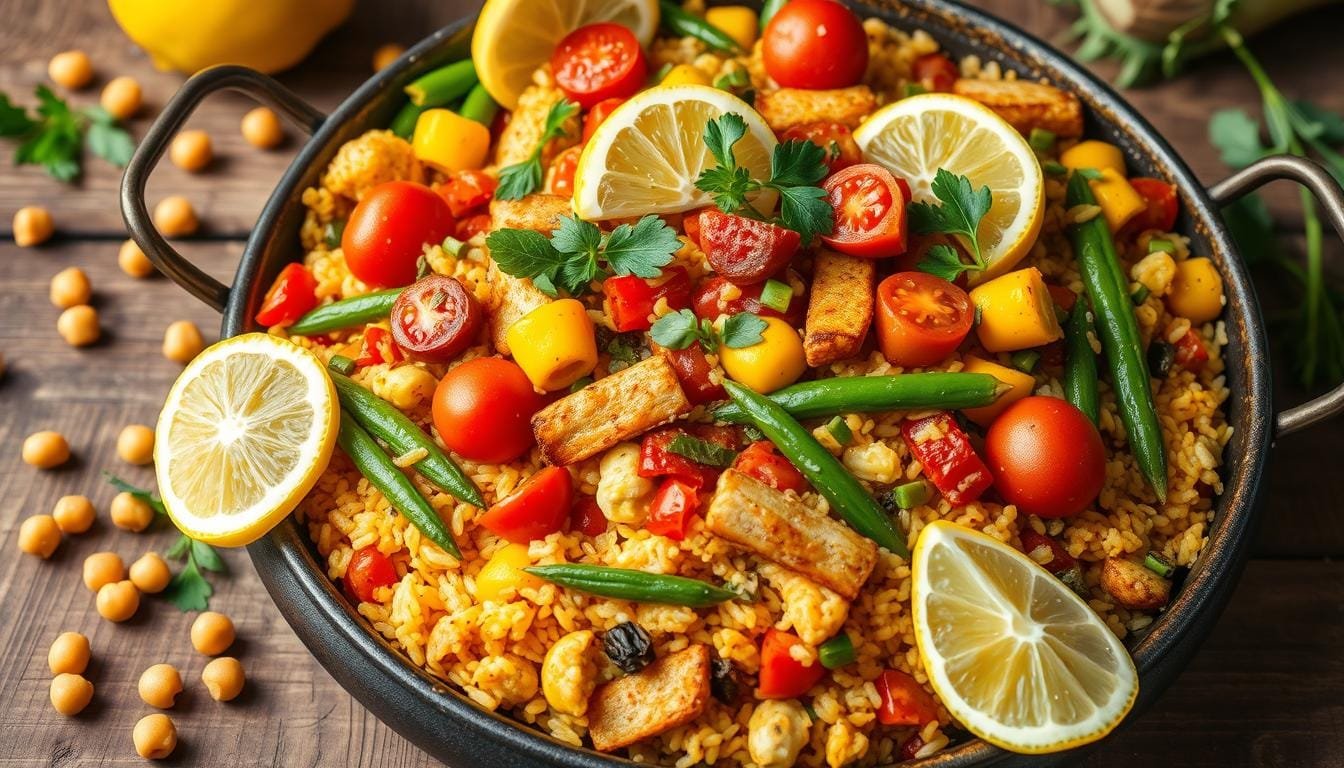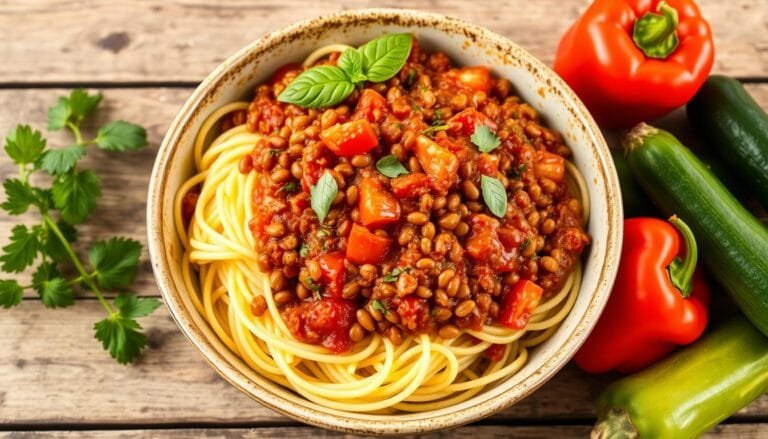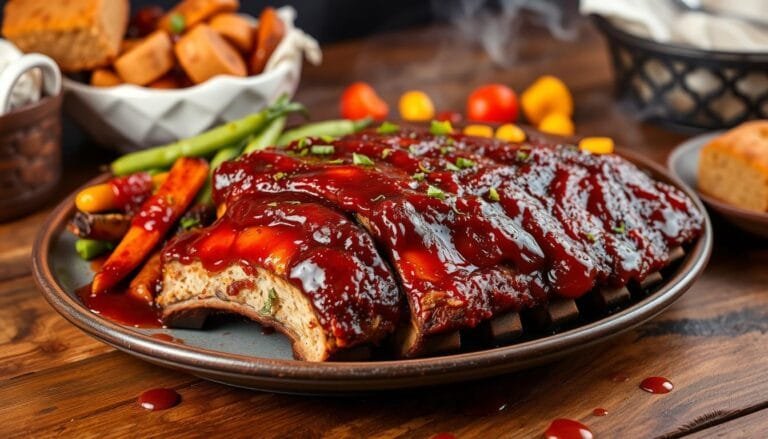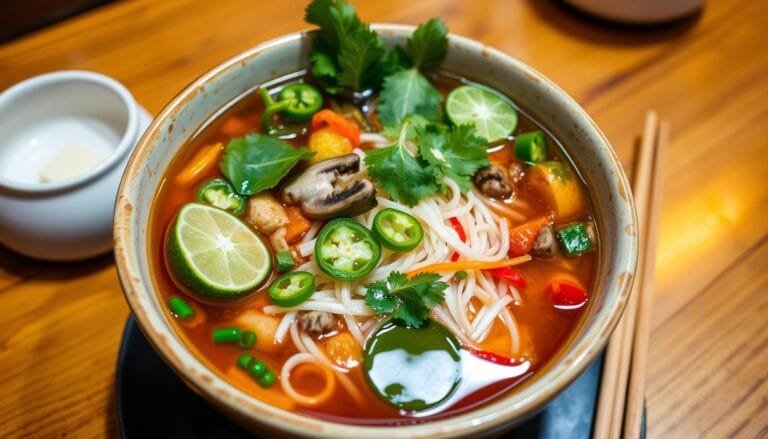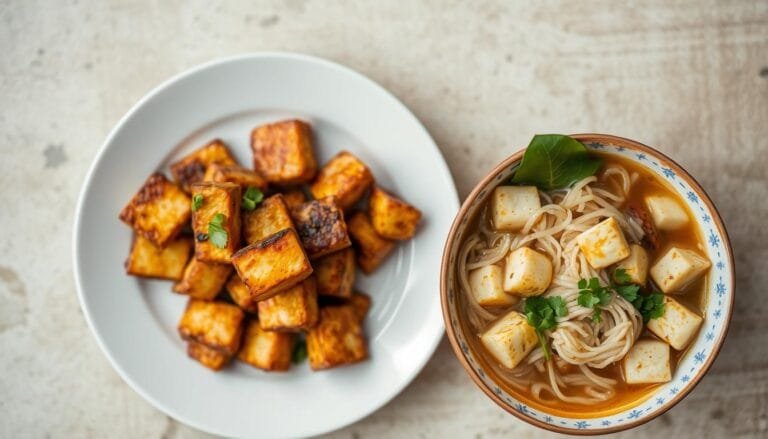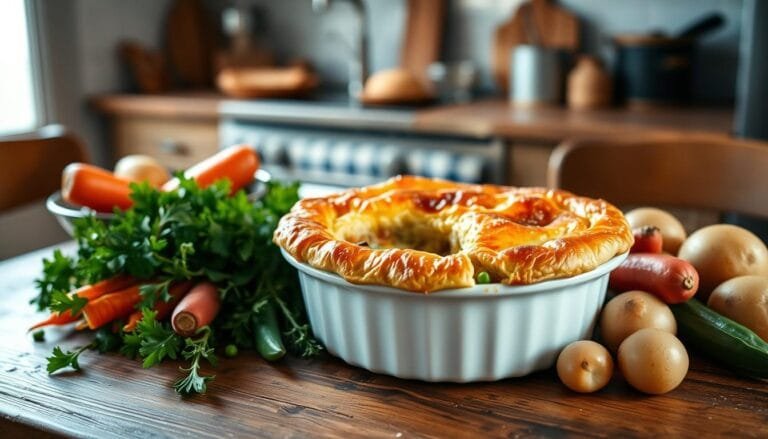I love cooking and exploring Spanish cuisine’s rich culture and flavors. Paella, with its saffron-infused rice, is a highlight. But, did you know you can make it vegan?
My vegan paella recipe is a game-changer. It keeps the golden rice, smoky taste, and crispy crust of traditional paella. This plant-based Spanish dish is a treat for your taste buds and a feast for the eyes, served in a classic paella pan.
The secret to my meat-free paella is not stirring the rice. This lets the socarrat (the crispy bottom) form perfectly. With the right veggies, proteins, and spices, every bite is a taste of authentic vegetarian Spanish cuisine.
Discovering Authentic Spanish Paella: A Traditional Dish Reimagined
Paella, the iconic Spanish dish, is known for its rich history and vibrant flavors. It comes from Valencia, a sun-soaked region. This dish is a mix of meat, seafood, and short-grain rice.
The Cultural Significance of Paella in Spanish Cuisine
In Spain, paella is more than food. It’s a tradition that brings families and communities together. Cooked in a large pan, it’s often shared during festive times or Sunday lunches.
This tradition shows the cultural importance of paella. It brings people together, creating shared experiences.
Why Choose a Plant-Based Version
Many are now choosing a plant-based Spanish food version of paella. This option is healthier and meets the demand for traditional paella for all diets. By using plant-based ingredients, the dish’s authentic flavors are preserved.
Making a vegan paella is easy. The dish’s essence is in its spices, vegetables, and rice. With creativity and the right techniques, plant-based paella is just as satisfying as the traditional version.
Essential Ingredients for the Perfect Vegan Paella
Making a delicious vegan paella needs careful picking of top-notch ingredients. The core of this Spanish dish is the key elements that mix to create a flavorful mix. Let’s explore the main parts that make up the best plant-based paella.
The base of vegan paella is the rice. Bomba or Calasparra rice, known for soaking up flavors and keeping their texture, are the best picks. Alongside the rice, a tasty vegetable broth is used. This broth is often mixed with saffron or turmeric for a bright color and smell.
- 1 ½ cups of uncooked Spanish Bomba Rice (300g)
- 4 cups of Vegetable Stock (960ml)
- 1 teaspoon of Saffron Threads, crumbled
Onions, garlic, and bell peppers are key, adding depth and complexity. Sautéed mushrooms, artichoke hearts, and juicy tomatoes also add to the vegetable mix.
| Ingredient | Quantity |
|---|---|
| Onion (White, Yellow, or Brown) | 1 Medium |
| Red Bell Pepper | 1 Medium |
| Portobello Mushrooms, sliced | 2 Large |
| Marinated Artichoke Hearts, quartered | ⅔ cup (165g) |
| Tomato, diced | 1 Large |
| Crushed Garlic | 2 Tablespoons |
Spices are key to boosting the flavor. Smoked paprika, sweet paprika, dried thyme, and a bit of cayenne pepper mix to capture Spanish cuisine’s essence.
Adding tofu, beans, or legumes gives a protein boost to vegan paella. You can choose what you like, making the dish your own.
The Secret to Golden Rice: Saffron vs. Turmeric
Two spices are key for paella’s golden color: saffron and turmeric. Saffron is the traditional choice, known for its unique taste. But it can be expensive. Turmeric is a cheaper option that can give a similar golden look to your paella.
Understanding Saffron’s Unique Properties
Saffron comes from the delicate stigmas of the Crocus sativus flower. It’s famous for its golden color and unique flavor. This flavor is earthy, slightly sweet, and floral. Saffron can make your plant-based paella taste and look authentic and appealing.
Budget-Friendly Turmeric Alternative
If saffron is too pricey, don’t worry. Turmeric, a yellow spice from the Curcuma longa root, is a great substitute. It doesn’t have saffron’s depth of flavor but can give your paella rice a beautiful golden color. Use about 1 teaspoon of ground turmeric to get a similar color without spending a lot.
Choosing between saffron and turmeric depends on your taste and budget. Find the right balance for your plant-based paella. Let the golden color of your rice be the highlight of your dish.
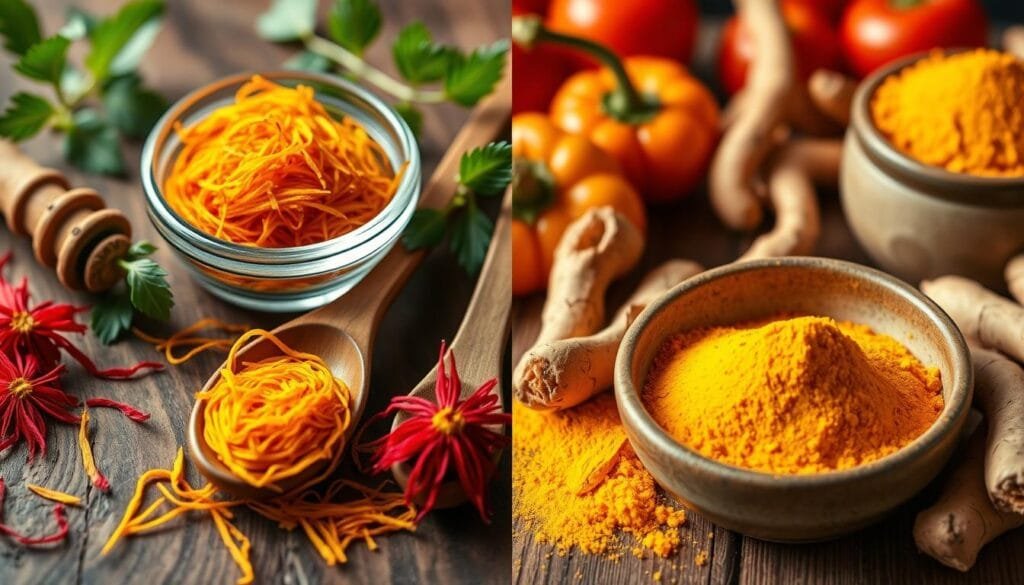
Choosing the Right Rice for Plant-Based Paella
Choosing the right rice is key for a great plant-based paella. Bomba rice is the top pick for paella. It’s known for soaking up flavors well while staying firm.
Calasparra rice is a good choice if you can’t find Bomba. It’s similar and works well in vegan paella. Arborio rice, used for risotto, can also work. It adds a creamy touch to the dish.
| Rice Type | Characteristics | Suitability for Paella |
|---|---|---|
| Bomba Rice | Short-grain, high absorption capacity | Ideal for paella, offers the right texture and flavor |
| Calasparra Rice | Short-grain, similar to Bomba | Great substitute for Bomba in paella |
| Arborio Rice | Short-grain, creamy texture | Can be used as a substitute, but not traditional |
| Brown Rice | Whole grain, higher in fiber and nutrients | Not recommended for paella due to longer cooking time |
The right rice makes a big difference in paella. Don’t stir the rice too much. This can make it too creamy, like risotto. Instead, let it cook undisturbed for the best texture and flavor.
The Art of Creating Socarrat: The Crispy Bottom Layer
Paella is famous for its crispy golden crust, called socarrat. This layer at the bottom adds a smoky and nutty taste. It makes the dish even better. For those who love plant-based paella, learning the socarrat technique is essential.
Tips for Achieving the Perfect Crust
Getting the perfect crispy paella bottom needs patience and a good understanding of cooking. Here are some tips to help you get it right:
- Use a wide, shallow pan: A traditional paella pan helps with even heat and a great crust.
- Resist the urge to stir: Let the rice cook undisturbed to form the socarrat.
- Adjust the heat: Start with high heat to toast the rice, then lower it for the crust to form.
- Be patient: Getting the perfect socarrat takes time. Don’t check on the paella too often.
Common Socarrat Mistakes to Avoid
The socarrat is a key part of paella, but it can be tricky. Here are some common mistakes to avoid:
- Overcrowding the pan: Too many ingredients can stop the rice from crisping up.
- Excessive stirring: Stirring too much can ruin the crust and make the paella soggy.
- Uneven heat distribution: Uneven heat can cause a patchy socarrat.
- Burning the crust: High heat for too long can burn the socarrat and make it taste bitter.
With practice and attention to detail, you can master the socarrat. This will take your plant-based paella to new levels of taste and texture.
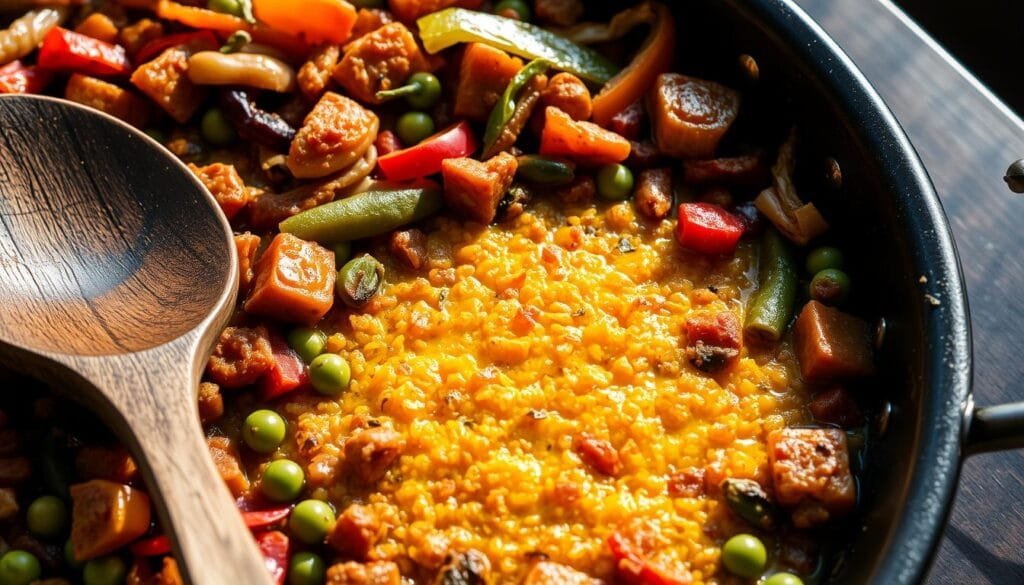
Selecting and Preparing Fresh Vegetables
Creating a delicious vegan paella starts with choosing and preparing fresh veggies. A colorful mix of vegetables for vegan paella can turn this Spanish dish into a feast for the eyes and taste buds.
Start by picking a variety of veggies for your paella vegetable prep. Bell peppers, tomatoes, peas, and artichokes add flavor and color. Zucchini, asparagus, or mushrooms can also be great additions for more variety and nutrients.
It’s important to prepare your plant-based paella ingredients right. Cut your veggies into similar sizes for even cooking. This way, every bite will be perfectly balanced.
Using frozen peas can make your paella prep easier. They add color and texture without extra work. Fresh herbs like parsley can also enhance the flavors and make your dish look vibrant.
“The secret to a truly exceptional plant-based paella lies in the quality and preparation of the fresh vegetables. By selecting the right ingredients and meticulously prepping them, you can create a dish that is both visually stunning and bursting with flavor.”
By carefully selecting and preparing fresh vegetables, you can make your vegan paella a masterpiece. Let the vibrant colors and textures of nature’s bounty shine in your dish. Your paella will be a celebration of the season’s best.
Plant-Based Protein Options for Your Paella
Creating a tasty vegan paella means picking the right plant-based proteins. Tofu and beans are great for adding protein without losing flavor. They make your paella both satisfying and nutritious.
Marinated Tofu Techniques
Tofu is a great choice for vegan paella. Marinate it in olive brine to get that seafood taste. This trick makes tofu taste and feel like the real thing.
Choose extra-firm tofu for the best results. Bake or air-fry it to get a crispy outside. This will make your paella even better.
Bean and Legume Alternatives
Beans and legumes are also great for adding protein to your paella. Try creamy butter beans, protein-rich chickpeas, or hearty cannellini beans. They add texture and nutrition.
For a meat-like option, use vegan chorizo or seitan. They blend well with other ingredients. This way, your paella will be delicious and packed with plant-based goodness.
By carefully choosing and preparing your vegan proteins, you can make a paella that’s both tasty and healthy. Try these methods to make a memorable and nutritious vegan Spanish dish.

“The key to a successful vegan paella is finding the right plant-based protein sources that can mimic the traditional flavors and textures of this beloved Spanish dish.”
Essential Kitchen Equipment and Paella Pans
Preparing vegan paella needs the right kitchen tools. A traditional paella pan is best, but not essential. Choose a wide, shallow pan made of high-quality stainless steel. It should have even heat for great paella cooking.
Stay away from non-stick pans. They can ruin the socarrat, the crispy bottom layer. Look for pans that help even heat and crust formation. This ensures your vegan paella is perfect every time.
If you don’t have a paella pan, a large stainless steel skillet or Dutch oven works. Make sure it’s wide enough for the rice to spread thinly. A lid helps with even cooking, but it’s not traditional.
| Pan Name | Size | Material | Price | Dishwasher Safe |
|---|---|---|---|---|
| Garcima Pata Negra Paella Pan | 13.5 inch diameter, 11 inch base | Carbon steel | $75 | No |
| Budget-Friendly Paella Pan | 14 inch diameter, 12 inch base | Carbon steel | Under $30 | No |
| Enameled Paella Pan | 14 inch diameter | Enameled steel | $18 | Yes |
The pan’s width is key. It lets the rice spread thinly for the perfect socarrat. Thinner metal pans are better for temperature control in paella cooking.

Whether you pick a traditional paella pan or a versatile stainless steel skillet, the right tools make a big difference. With the right equipment and practice, you’ll make delicious plant-based paellas. They’ll take you straight to Spain’s heart.
Step-by-Step Cooking Process
Making a tasty vegan paella is all about the cooking steps. First, I sauté diced onions, bell peppers, and garlic in olive oil. This makes them fragrant and soft. It’s the start of the flavors for my vegan paella.
Then, I add short-grain rice like Bomba or Arborio. I let it toast for a minute or two. This coats the rice in the tasty oil. Next, I add warm vegetable broth and saffron or turmeric for color. I boil it, then lower the heat and cover it. The rice simmers for 15-20 minutes without stirring.
- Sauté the onions, bell peppers, and garlic in olive oil until softened.
- Add the short-grain rice and toast it for a minute or two.
- Pour in the vegetable broth and saffron/turmeric, then bring to a boil.
- Reduce heat to low, cover, and simmer for 15-20 minutes without stirring.
While the rice cooks, I hear a crackling sound. This means the socarrat – the crispy bottom layer – is forming. I don’t stir it, as stirring could ruin the crust.
When the rice is tender and the liquid gone, I turn off the heat. I let it rest for a few minutes. This lets the flavors mix and the socarrat set. Then, I serve the plant-based paella with lemon wedges and parsley.
By following these steps, I make a vegan paella that tastes just like the real thing. It’s a delicious vegan twist that everyone will love.
Seasoning and Spice Combinations
Making the perfect vegan paella is all about mastering flavors. At its heart, a mix of aromatic spices and seasonings takes you to Valencia’s vibrant streets.
Traditional Spanish Flavor Profiles
The base of a great paella is paella seasoning, Spanish spices, and a bit of acidity. Saffron, the golden threads, is essential. Or, use turmeric for a cheaper, yet vibrant, option.
Smoked paprika, or pimentón, adds depth and a smoky taste. Garlic is a must, bringing a bold, aromatic flavor to every bite.
Building Layers of Taste
- Begin with quality olive oil for sautéing onions and garlic.
- Use white wine or vegetable broth to deglaze, getting all the flavors from the bottom.
- Add diced tomatoes for sweetness and acidity.
- Finish with salt and optional herbs like bay leaf, rosemary, or thyme for more depth.
Layering these flavors makes a vibrant, balanced paella that captures Spanish cuisine’s essence. The goal is to let each flavor shine while blending them perfectly, creating a plant-based masterpiece.
Serving and Presentation Tips
Serving your vegan paella right is all about authenticity and looks. Serve it in the cooking pan for a traditional touch. This keeps the dish’s rustic charm and lets guests enjoy the crispy socarrat at the bottom.
For a pop of color and flavor, garnish with fresh lemon wedges, parsley, and olives. The lemon adds a zesty kick, parsley brings a fresh aroma, and olives add a savory taste.
To make your paella look amazing, arrange extra veggies like roasted peppers or mushrooms on top. This adds color, texture, and more flavor.
Present your paella hot, with the socarrat crisp. Serve it with a glass of chilled Spanish wine or sangria for a complete experience.
“Paella is not just a dish, it’s a celebration of Spanish culture and tradition. The way you serve and present it is an integral part of the experience.”
Storage and Reheating Guidelines
Enjoying leftover plant-based paella is a great idea. It can be stored and reheated easily. Keep it in an airtight container in the fridge for up to 5 days. This way, you can enjoy it for a few more meals.
To reheat, use a lightly oiled skillet over medium heat. This method helps keep the crispy socarrat layer. You can also reheat it in the oven at 350°F for 20-30 minutes. The microwave works too, but it might change the rice’s texture a bit.
For longer storage, freeze the paella for 1-2 months. But, the rice might get mushy after thawing and reheating. To keep the texture, add fresh herbs or a bit of vegetable broth when reheating frozen paella. With proper storage and reheating, you can enjoy this Spanish classic for days.
